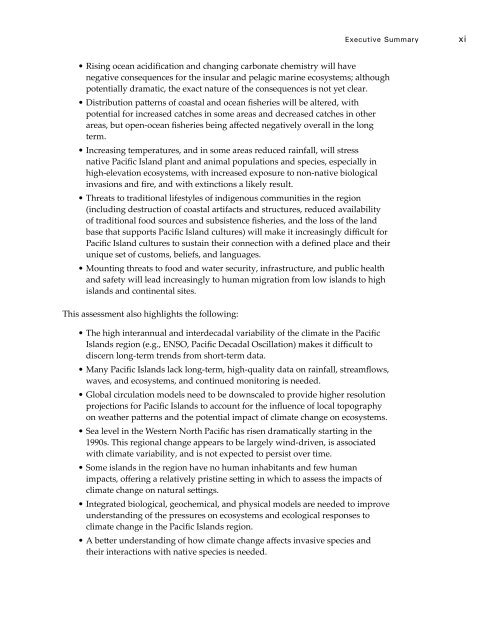(PIRCA), this report - Climate Adaptation Knowledge Exchange
(PIRCA), this report - Climate Adaptation Knowledge Exchange
(PIRCA), this report - Climate Adaptation Knowledge Exchange
Create successful ePaper yourself
Turn your PDF publications into a flip-book with our unique Google optimized e-Paper software.
Executive Summary<br />
xi<br />
• Rising ocean acidification and changing carbonate chemistry will have<br />
negative consequences for the insular and pelagic marine ecosystems; although<br />
potentially dramatic, the exact nature of the consequences is not yet clear.<br />
• Distribution patterns of coastal and ocean fisheries will be altered, with<br />
potential for increased catches in some areas and decreased catches in other<br />
areas, but open-ocean fisheries being affected negatively overall in the long<br />
term.<br />
• Increasing temperatures, and in some areas reduced rainfall, will stress<br />
native Pacific Island plant and animal populations and species, especially in<br />
high-elevation ecosystems, with increased exposure to non-native biological<br />
invasions and fire, and with extinctions a likely result.<br />
• Threats to traditional lifestyles of indigenous communities in the region<br />
(including destruction of coastal artifacts and structures, reduced availability<br />
of traditional food sources and subsistence fisheries, and the loss of the land<br />
base that supports Pacific Island cultures) will make it increasingly difficult for<br />
Pacific Island cultures to sustain their connection with a defined place and their<br />
unique set of customs, beliefs, and languages.<br />
• Mounting threats to food and water security, infrastructure, and public health<br />
and safety will lead increasingly to human migration from low islands to high<br />
islands and continental sites.<br />
This assessment also highlights the following:<br />
• The high interannual and interdecadal variability of the climate in the Pacific<br />
Islands region (e.g., ENSO, Pacific Decadal Oscillation) makes it difficult to<br />
discern long-term trends from short-term data.<br />
• Many Pacific Islands lack long-term, high-quality data on rainfall, streamflows,<br />
waves, and ecosystems, and continued monitoring is needed.<br />
• Global circulation models need to be downscaled to provide higher resolution<br />
projections for Pacific Islands to account for the influence of local topography<br />
on weather patterns and the potential impact of climate change on ecosystems.<br />
• Sea level in the Western North Pacific has risen dramatically starting in the<br />
1990s. This regional change appears to be largely wind-driven, is associated<br />
with climate variability, and is not expected to persist over time.<br />
• Some islands in the region have no human inhabitants and few human<br />
impacts, offering a relatively pristine setting in which to assess the impacts of<br />
climate change on natural settings.<br />
• Integrated biological, geochemical, and physical models are needed to improve<br />
understanding of the pressures on ecosystems and ecological responses to<br />
climate change in the Pacific Islands region.<br />
• A better understanding of how climate change affects invasive species and<br />
their interactions with native species is needed.

















